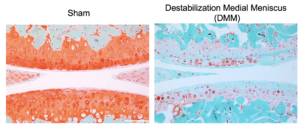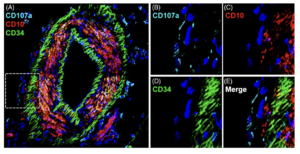Perivascular cells are mesenchymal-like progenitor cells located across normal and tumor tissue. Our past work on bone and soft tissue perivascular cells from human and mouse sources have examed their cellular characteristics and identified the functional markers of osteoprogenitor cells. Present work focuses on the diseased perivascular stem cell niche and its mechanisms. See below for several links to publications.
-
- Comparison of Human Tissue Microarray to Human Pericyte Transcriptome Yields Novel Perivascular Cell Markers
- Lysosomal protein surface expression discriminates fat- from bone-forming human mesenchymal precursor cells
- Comparison of skeletal and soft tissue pericytes identifies CXCR4+ bone forming mural cells in human tissues
- Human perivascular stem cell-derived extracellular vesicles mediate bone repair
 Degenerative joint diseases
Degenerative joint diseases
Degenerative joint diseases such as osteoarthritis and temporomandibular disorders have impacted more than 30% of U.S. population. Numerous growth factors and differentiation pathways are involved in these processes. Our efforts are dedicated to defining the disease mechanisms and regulatory pathways which will aid in the reparative process. See below for several links to publications.
- Divergent effects of distinct perivascular cell subsets for intra-articular cell therapy in posttraumatic osteoarthritis
- Endogenous CCN family member WISP1 inhibits trauma-induced heterotopic ossification
- Perivascular Fibro-Adipogenic Progenitor Tracing during Post-Traumatic Osteoarthritis
- Platelet-derived growth factor receptor-β (PDGFRβ) lineage tracing highlights perivascular cell to myofibroblast transdifferentiation during post-traumatic osteoarthritis
Biomaterials for bone repair

Numerous growth factors are produced and regulate mineralized tissue development and the reparative process. We have identified and utilized novel exogenous applications of positive regulators of Hedgehog and Wnt signaling in promoting bone healing in calvarial, axial, and appendicular skeletons. See below for several links to publications.
- Development of a Biomaterial Scaffold Integrated with Osteoinductive Oxysterol Liposomes to Enhance Hedgehog Signaling and Bone Repair
- The antimicrobial and osteoinductive properties of silver nanoparticle/poly (DL-lactic-co-glycolic acid)-coated stainless steel
- Fibromodulin Enhances Angiogenesis during Cutaneous Wound Healing
 Perivascular progenitor cells
Perivascular progenitor cells